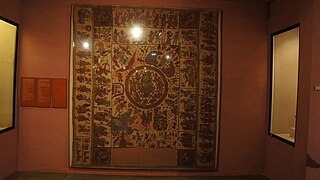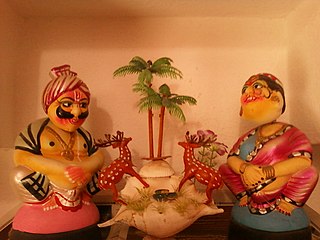 W
WThe culture of Andhra Pradesh state in India has many aspects.
 W
WAndhra Natyam comprises Aagama Narthanam, Aasthana Narthanam and Prabhandha Narthanam. Andhra Natyam is performed by both men and women.
 W
WLepakshi Handicrafts is a unit of Andhra Pradesh Handicrafts Development Corporation Ltd. which is an agency of Government of Andhra Pradesh established in 1982 to develop, preserve and promote the rich tradition of exquisite craftsmanship of Andhra Pradesh.
 W
WBobbili veena is a large plucked string instrument used in Carnatic classical music. The Veena is named after Bobbili, a place where it was invented. In 2011 the musical instrument got a Geographical Indication tag from the Government of India.
 W
WThe Buddhapad Hoard or Buddam Hoard is a large cache of Buddhist sculptures found near the town of Buddam in Andhra Pradesh, southern India. Since 1905, it has formed an important part of the British Museum's South Asian collection. Dating from 6th-8th centuries AD, the style of craftsmanship fuses the northern influences of the Gupta period with the southern traditions of the Deccan, which in turn greatly influenced Buddhist art in South East Asia in subsequent centuries.
 W
WBurra Katha, also spelled Burrakatha, is an oral storytelling technique in the Jangam Katha tradition, performed in villages of Andhra Pradesh and Telangana. The troupe consists of one main performer and two co-performers. It is a narrative entertainment that consists of prayers, solo drama, dance, songs, poems and jokes. The topic will be either a Hindu mythological story or a contemporary social issue. It became popular art form during the Telangana Rebellion in the early 1930-1950.
 W
WCockfighting in India primarily takes place in January, coinciding with Makar Sankranti. The practice is widespread in coastal districts of Andhra Pradesh, including Krishna, Guntur, East Godavari and West Godavari districts, despite being illegal in India.
 W
WEastern Chalukyas, also known as the Chalukyas of Vengi, were a dynasty that ruled parts of South India between the 7th and 12th centuries. They started out as governors of the Chalukyas of Badami in the Deccan region. Subsequently, they became a sovereign power, and ruled the Vengi region of present-day Andhra Pradesh until c. 1130 CE. They continued ruling the region as feudatories of the Cholas until 1189 CE.
 W
WThe Gajapati Empire was a Royal dynasty established by the Suryavamsa or Routray dynasty, who were a medieval Hindu dynasty from the Indian subcontinent, which originated in the region of Odradesha from 1434 to 1541 CE. Under Kapilendra Deva, Gajapatis became an empire stretching from the lower Ganga in the north to the Kaveri in the south.
 W
WGudhi Padwa is a spring-time festival that marks the traditional new year for Marathi and Konkani Hindus along with other fellow Hindus. It is celebrated in and near Maharashtra and Goa on the first day of the Chaitra month to mark the beginning of the New year according to the lunisolar Hindu calendar. The word padava or padavo comes from the Sanskrit word pratipada which refers to the first day of a lunar fortnight. The festival is observed with colourful floor decorations called rangoli, a special Gudhi flag, street processions, dancing and festive foods.
 W
WHarikatha, also known as Harikatha Kaalakshepam in Telugu and Tamil, is a form of Hindu traditional discourse in which the storyteller explores a traditional theme, usually the life of a saint or a story from an Indian epic. The person telling the story through songs, music and narration is called a Haridasa.
 W
WKalamkari is a type of hand-painted or block-printed cotton textile produced in Isfahan, Iran, and in the Indian state of Andhra Pradesh. Only natural dyes are used in Kalamkari, which involves twenty-three steps.
 W
WA katcheri is an assembly of musicians and audience in the context of Carnatic music or Karnatick music. It is presented in the concert format. The music fraternity of connoisseurs and common people assemble at the katcheri venues to listen to classical music concerts of vidwans. Etymologically the word "katcheri" is derived from Urdu language and in Hindi to mean a court of law.
 W
WKolam, also known as Muggu or Tharai Aalangaram is a form of traditional decorative art that is drawn by using rice flour as per age-old conventions. It is also drawn using white stone powder, chalk or chalk powder, often along with natural or synthetic color powders. Its origin belongs to the ancient Tamil Nadu known as Tamilakam and has since spread to the other southern Indian states of Karnataka, Telangana, Andhra Pradesh, and Kerala. It can be found in some parts of Goa and Maharashtra. Since the Tamil diaspora is worldwide, the practice of kolam is found around the world, including in Sri Lanka, Singapore, Malaysia, Indonesia, Thailand and a few other Asian countries. A kolam or muggu is a geometrical line drawing composed of straight lines, curves and loops, drawn around a grid pattern of dots. In Tamil Nadu and Sri Lanka, it is widely practised by female family members in front of their house entrance. The similar regional versions of kolam with their own distinctive forms are known by different names in India: raangolee in Maharashtra, aripanin Mithila, and hase and rangoli in Kannada in Karnataka. More complex kolams are drawn and colors are often added during festival days, holiday occasions and special events.
 W
WKondapalli Toys are toys made of wood in Kondapalli of Krishna district, a nearby Vijayawada in the Indian state of Andhra Pradesh. Bommala Colony translates to Toys Colony in Kondapalli is the place where the art of crafting takes place. It was registered as one of the geographical indication handicraft from Andhra Pradesh as per Geographical Indications of Goods Act, 1999. These toys were one of the varieties of toys assembled in the houses during the festivals of Sankranti and Navratri and is referred as Bommala Koluvu.
 W
WKrishnadevaraya was an emperor, of the Vijayanagara Empire, who reigned from 1509–1529. He was the third ruler of the Tuluva Dynasty and is considered to be its greatest ruler. He possessed the largest empire in India after the decline of the Delhi Sultanate. Presiding over the empire at its zenith, he is regarded as an icon by many Indians. Krishnadevaraya earned the titles Kannada Rajya Rama Ramana, Andhra Bhoja, Gaubrahmana Pratipalaka and Mooru Rayara Ganda. He became the dominant ruler of the peninsula of India by defeating the Sultans of Bijapur, Golconda, the Bahmani Sultanate and the Gajapatis of Odisha, and was one of the most powerful Hindu rulers in India. Indeed, when the Mughal Emperor Babur was taking stock of the potentates of north India, Krishnadevaraya was rated the most powerful and had the most extensive empire in the subcontinent.
 W
WKuchipudi is one of the eight major Indian classical dances. It originated in a village named Kuchipudi in the Indian state of Andhra Pradesh.
 W
WMaa Telugu Talliki is the official song of the Indian state of Andhra Pradesh. The Telugu Thalli is portrayed as a symbol of Telugu people. Many schools and government events start with this song, showing respect to the Telugu-language.
 W
WA mangala sutra or thaali is a necklace that the groom ties around the bride's neck in the Indian subcontinent, in a ceremony called Mangalya Dharanam. The necklace serves as a visual marker of status as a married woman.
 W
WThere were eminent mridangam artists like "Mrudanga Kesari" Mullapudi Lakshmana Rao and his son Mullapudi Sri Rama Murty. And his disciple " Mrudanga Shiromani" Dharmala Rama Murty and his son Dharmala Venkateshwara Rao. There were other legends like ML Lakshminarayana Raju and Kamalakara Rao.
 W
WNalugu Rallu Aata is a very ancient traditional outdoor four-player game played by the children of the past generation, until the late 1960s and 1980s in many rural districts of Andhra Pradesh State. The origin and the birth of this game is unknown. Today this game has completely vanished due to urbanization and invasion of western games.
 W
WPedana Kalamkari also known as Machilipatnam style of Kalamkari work which involves vegetable dyed block-painting of a fabric. it is produced at Pedana a nearby town of Machilipatnam in Krishna district of the Indian state of Andhra Pradesh. It was registered as one of the geographical indication from Andhra Pradesh under handicraft goods by Geographical Indications of Goods Act, 1999.
 W
WA racchabanda is a raised platform typically built under the shade of a huge tree, common in Andhra Pradesh. The tree may be Ficus benghalensis or Sacred fig or Jambul or Tamarind. The platforms may be built with sedimentary rocks or bricks or cement. Historically Racchabandas came into existence in India before the Medieval period. Rachabandas can also be found in several rural villages throughout India.
 W
WTelugu cinema, also known as Tollywood, is the segment of Indian cinema dedicated to the production of motion pictures in the Telugu language, widely spoken in the states of Andhra Pradesh and Telangana. Telugu cinema is based in Film Nagar, a neighbourhood of Hyderabad, India. The nickname Tollywood is a portmanteau of the words Telugu and Hollywood.
 W
WThe Telugu Hindu wedding ceremony is the traditional wedding ceremony of the Telugu people in India. In the 19th century, the ceremony could last up to sixteen days. In modern times, it can last two or more days, depending on the family's financial and social status. The pelli or wedding is considered the strongest of social bonds, and is said to spiritually merge two souls opening the doors to gruhastaashramam. There is a Telugu saying that "Marriage is supposed to be a family union and not an individual formality." However, with changing mindset of the younger generation and due to globalization, marriage these days is being mainly focused solely on the union of the young couple only.
 W
WTholu bommalata is the shadow puppet theatre tradition of the state of Andhra Pradesh in India. Its performers are part of a group of wandering entertainers and peddlers who pass through villages during the course of a year and offer to sing ballads, tell fortunes, sell amulets, perform acrobatics, charm snakes, weave fishnets, tattoo local people and mend pots. This ancient custom, which for centuries before radio, film, and television provided knowledge of Hindu epics and local folk tales, not to mention news, spread to the most remote corners of the Indian subcontinent. Tholu bommalata literally means "the dance of leather puppets".
 W
WUgadi or Yugadi, also known as Samvatsarādi, is the New Year's Day for the states of Andhra Pradesh, Telangana, and Karnataka in India. It is festively observed in these regions on the first day of the Hindu lunisolar calendar month of Chaitra. This typically falls in April month of the Gregorian calendar.
 W
WVaddanam is a gold ornamental belt worn by South Indian women on special occasions.
 W
WVisakhapatnam, also known as Vizag, is a city and port in the South India state of Andhra Pradesh. Visakhapatnam has long history since 1068 AD inscriptions of Sri Bheemeswara Swamy temple, 4th largest city in south india.
 W
WVogeti or Ogeti is a Hindu surname used by a particular aristocratic family mainly based in Rajahmundry, Andhra Pradesh, India. It is one of the Merakaveedhi Telaga Martial race.